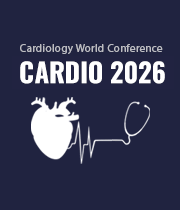Title : Role of temporal and spatial electrophysiological heterogeneity and variability in the initiation of re-entrant ventricular arrhythmia
Abstract:
Re-entrant ventricular tachyarrhythmia can be life-threatening and require an initiating trigger and susceptible substrate. Their onset is unpredictable and has a higher probability when repolarization is delayed (long QTc, or myocyte action potential duration at 90% repolarization (APD90)), and when the heterogeneity of myocardial tissue electrophysiology (APD90 and propagation velocity) and architecture (fibrosis) is enhanced. Here we map the effects of variability in cell ionic channel conductance parameters in homogenous populations of myocytes on the probability of pro-arrhythmogenic triggers, and surrogate markers of arrhythmogenicity in heterogenous tissue (APD90 dispersion, Early After Depolarization (EAD), alternans and vulnerability). Human ventricular isolated cardiomyocyte electrophysiology was modelled by the O’Hara, Virag, Verro & Rudy 2011 model for subendocardial and midmyocardial cells, with conductance parameter values randomly perturbed, to produce cell populations, and a reduction of the maximal conductance gKr of the rapidly delayed K+ rectifier current, to simulate LQT2. Action potentials are quantified by APD restitution curves, APD histograms, and the probability of pro-arrhythmogenic cellular events (EADs, repolarization failure, and alternans).
Reducing gKr prolongs APD90 smoothly, with a 40% prolongation in APD90 simulating LQT2 produced by a 47.5% reduction in gKr. When all the maximal ionic conductances are Gaussian distributed with a 5% standard deviation about their standard values, and limited to 4 standard deviations from the mean, the action potentials could be shortened or prolonged, include an EAD, or fail to repolarize. APD90 and coefficient of variation with periodic pacing at 1/s for populations of sub endocardial and mid-myocardial cells are 266.3 ± 8.8ms, 3.3% and 375.1 ±10.4ms, 2.7%; and for the LQT model 380.9 ±17.3ms, 4.5% and 501.8 ± 27.3ms, 5.4%. The effect of the reduced gKr on the dispersion of APD90 (a surrogate for T-wave dispersion) between sub-endocardial and midmyocardial cells is increased by 9.3% from 66.6 to 72.8ms at a pacing rate of 1/s, and for cell populations the dispersion is increased by 72%, from 150.3 to 258.3ms. The probabilities of EADs and repolarization failure are < 0.005 for the subendocardial model and for midmyocardial cell LQT model.
Computed circadian changes based on primate ionic channel mRNA transcriptomic data produce a maximum-to-minimum 20ms, 7% modulation in APD90 at a rate of 1/s, and menstrual cycle changes based on plasma hormone levels and their effects on in vitro myocytes produce a 10% (sub-epi/endocardial) to 15% (mid-myocardial) modulation in models with channel expression modified by electrophysiological data from cells from women. These slow changes interact nonlinearly with the effects of population variability, giving EADs an exaggerating dispersion in female models, especially around the time of ovulation. Spatial electrophysiological heterogeneity exaggerated by variability in ionic conductances increases APD90 dispersion and pro-arrhythmic trigger probability, as illustrated for LQT2. Hormonal and circadian modulation of ion channel expression further amplifies this effect, especially in female models. In addition to genomics, dynamic transcriptomic regulation and physiological inputs critically shape arrhythmia susceptibility. The risk of initiating an arrhythmia in an individual is determined by the extreme values of distributions, and not a single number, but changes over time.
Keywords: Long QT Syndrome, Repolarization, Arrhythmias, Spatial heterogeneity, Temporal Variability.



